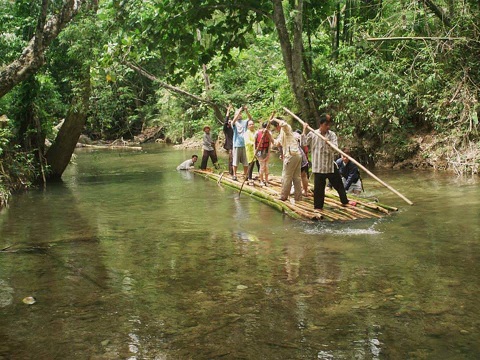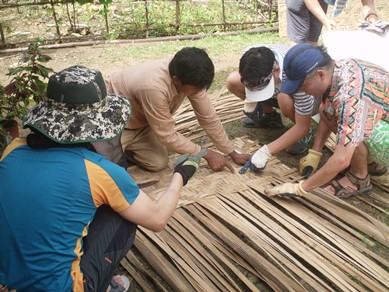By COOPER RESABAL
MARIBOJOC, Bohol – A community-based tourism program has become a rehabilitation alternative for a village that was severely damaged by the October 15, 2013 earthquake in the tourist island of Bohol in the central Philippines.
Barely six months after the 7.2 intensity tremor that damaged many structures, including houses and century-old heritage churches in the island province, volunteer tourism is helping revive barangay Toril, a village of 115 households in this fourth class town.
Toril is the site of the Bol-anon Village Cultural and Nature Trails (BVCNT), a rehabilitation program which invites volunteer tourists to help build shelters and also to experience the community’s unique cultural practices and natural heritage sites.
The program provides a variety of activities for volunteers to the Work Camp for Shelter in Bohol and ensures continuation of rehabilitation after the activity, says Isabelita Moncano, Maribojoc Rehabilitation Shelter Officer. It is a unique approach to the drastic social and environmental changes that took place after the Oct. 15, 2013 tremor, she adds.
Working with the locals of Toril, volunteers dug holes to lay down the shelter foundation, carved the calado that will add ventilation to the house, and wove bamboo strips to create the amakan wall.
The Bol-anon Village Cultural and Nature Trails program divides the village into three trails: the Fiesta or Harvest Trail, the Crafts Trail, and the Nature Experience Trail, Melyn Borcelas, BVCNT executive council member, explains.
Through stories and showcases of Boholano songs and dances, the locals of Toril share their well loved traditions and practices in the Fiesta Trail. Volunteers learn some traditional crafts, like the making of puso (hanging rice), and rice containers baojot and puko, while others learn how some Boholano dishes are prepared in the process of building earthquake rehabilitation shelters, Borcelas adds.
The Nature Experience Trail takes the volunteer tourists to a nature trek, which culminates in a bamboo rafting at the Napo River in Toril, relates Serg Nino Talinda, BVCT Nature Trek in charge. ”Like in a time travel, there are 1900s Bohol period scenarios along the way” making the visitors feel they are in a different period, he points out.
Richard Philip Gonzalo, professor of the Asian Institute of Tourism of the University of the Philippines, who brought 34 students and doctors here in February and tourism professors from Wakayama University of Japan in early May, says the experience in the Bol-anon Village provided the volunteer tourists with a different concept of travel.
“Instead of it being a purely enjoyable experience, the tour aimed at introducing a culture and helping the people in Toril in their recovery (from the earthquake aftermath) at the same time,“ Gonzalo says.
Charlo Tengco, a volunteer from AIT, described the experience as “one of a kind” and hopes he will be able to go back and help the community again. “I know the day will come the community will fully recover from the disaster.”
 Ester Isberto, 60, a development consultant, who brought her whole family of ten for a one day package, said the Bol-anon Village gave her family, including two grandchildren, a chance to experience the peculiar Bohol island village culture, and to commune with nature.
Ester Isberto, 60, a development consultant, who brought her whole family of ten for a one day package, said the Bol-anon Village gave her family, including two grandchildren, a chance to experience the peculiar Bohol island village culture, and to commune with nature.
“My apos had a great time with the cows, especially the calf which enjoyed the little one’s caring attention. This gave them an experience with nurturing.”
Kumi Kato, a professor at Wakayama University who stayed for four days in a Boholano cottage, said: “We really had a fantastic time and we are looking forward to bringing our students next time.” She added that in the community, “everyone can play multiple roles, which gets forgotten when one lives in an urban area.”
AIT and the Wakayama University professors have expressed their intention to have a partnership with the Bol-anon Village Cultural and Nature Trails.
In a message sent through Facebook, Kato said: “Some of our students are really interested in coming to stay in your community to help you with the Cultural Trail plans, hosting volunteers, working with the community members to really set up the cultural tourism plan.”
Administrative Order No. 2011 of the Department of Environment and Natural Resources states that “it is the policy of the State to provide opportunities for gainful and sustainable livelihood in a healthful, ecologically balanced environment to local communities.”
“In pursuit of this policy, community based ecotourism is hereby adopted as an area-based intervention to poverty alleviation and to ensure the sustainable use and management of natural resources and the protection and enhancement of the quality of the environment for the benefit of present and future generations,” the document reiterates.





